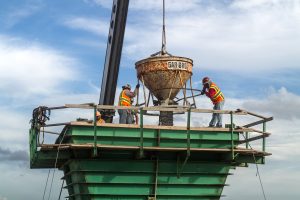Scaffold platforms are arguably the most important component of a scaffold but yet are probably the least understood. Questions repeatedly arise about the strength of platforms, the expectations that users have for platforms, and the requirements that various regulatory agencies have developed for scaffold erectors and users. While an engineering analysis will determine if a platform is strong enough and conforms with applicable standards and expectations, platform analysis is usually attempted in other ways. The tried and sometimes true method is the classic “deflection” approach: Load the platform until it starts to sag. As long as the platform doesn’t break, it must be okay! Of course this method is somewhat subjective since your opinion of excessive sag may be completely different than my opinion of excessive sag. Lucky for us, the Federal Occupational Safety and Health Administration (OSHA), has recognized this dilemma; OSHA limits the deflection to 1/60th of the span. (29CFR 1926.451(f)(16)
A better idea is to utilize a scientific approach that is more precise and methodical. This procedure results in precise load limits that are reliable and safe. A proper analysis addresses the three basic aspects of a well built platform: Safety, stability, and strength. Safety of the platform is easily addressed by providing fall protection for the occupants. Fall protection is a guardrail system, personal fall arrest equipment, or both, depending on the type of scaffold you are using. The stability of a platform includes the proper support for the platform so it does not slip off and fall, securing the platform components so they do not slip or slide, and making sure that all components cannot be easily displaced. Regulations address these concerns by specifying the minimum overhang of wood plank and the requirement that platform units be secured from movement.
Platform strength involves the selection of appropriate components for the work and materials that are expected to be on the platform. Consequently, it is important to know what the scaffold is being used for. A scaffold platform that is intended to support workers only will not be adequate for large storage of materials. On the other hand, a scaffold designed and erected to support workers and considerable storage of materials but used only to support workers is an inefficient and costly use of labor and materials. Therefore, the first step in the design and analysis of a scaffold platform is determining the work activity. If solid sawn scaffold grade wood plank is used, charts provided by OSHA, (29CFR1926, Subpart L, Appendix A(1)(c), and other organizations, can be used. This eliminates the need for analysis since this work was done in the development of the charts.
If manufactured products are used, such as laminated veneer lumber, aluminum, steel, wood, or plastic hook planks, fabricated decks, stages, and other proprietary products, the manufacturers can supply the data needed for analysis. For example, all fabricated scaffold decks and fabricated planks and platforms, (hook plank and stages), will have a duty or load rating indicated on the product, informing the user of the maximum capacity of that particular product. This load rating will be indicated as a permissible loading per square foot or the maximum number of persons. For example, a 7’-0” by 20 inch wide hook plank may have a rating of 75 pounds per square foot. This means that the plank will hold about 560 pounds evenly distributed across the plank. On stages, the allowable load is usually indicated as the number of persons it can hold. For example, the rating may indicate the stage is rated as a two person stage. This would mean two 250 pound loads is the limit of the stage. More information concerning duty ratings can be found in Appendix A of the Federal OSHA Construction Industry Standards, 29CFR1926, Subpart L, Appendix A(1)(c), and the American National Standards Institute, A10.8-1988.
If other products, such as wood joists and plywood are used, an analysis is necessary prior to the installation of the products. Specie and grade of lumber must be specified to guarantee that a safe platform is constructed. Additionally, proper bearing for the plywood is critical to the stability of the platform and should not be overlooked. Using the right materials allows the erector to construct a platform that spans long distances and carries heavy loads. Typically these platforms are limited only be accessibility of materials and the limitations of the erectors.
Sometimes scaffold grade plank are used with plywood. Typically the plank will be used as “skip-plank” with plywood on top. Basically this is using plank at 18-1/2 inches on center with plywood at least ½ inch thick as the working surface. This is an acceptable deck provided the work activity does NOT overload the deck. A skip plank platform will not support 25 pounds per square foot as many people might think. (It should be obvious that with a platform that has only half the plank, the allowable loading should be about half.) This does not mean that this platform is illegal or hazardous. Federal OSHA standards clearly specify that: “each scaffold and scaffold component shall be capable of supporting without failure, its own weight and at least 4 times the maximum intended load applied or transmitted to it.” It is interesting to note that nowhere in the standards does it state that a scaffold platform must support a minimum load of 25 pounds per square foot. In fact, if there was such a requirement, many scaffolds would be in violation of the standard.
There are many other materials that can be used to construct a scaffold platform. It is important that no matter what material is used, the platform is designed by a qualified person and constructed in accordance with that design. Not only does OSHA require it, (29CFR1926.451(a)(6)), but good construction practice demands it. The intent of the standards, and the purpose of design and analysis is to ensure that the platform is safe for its intended use. Think about it; a platform is typically a worker’s only support. The rest of the scaffold will not help a worker falling through a failed platform. Think about that the next time you slap a platform together and say it’s good enough.













